Use Cases for Data Views
This section describes use cases for LDAP data views. All of the examples assume that the connection handler allows all client connections to be processed by Directory Proxy Server.
For examples of data views in different deployments, see the following sections:
-
Data Views to Route All Requests, Irrespective of the Target DN of the Request
-
Data Views to Route Requests When Different Parts of a Subtree Are Stored in Different Data Sources
Data Views to Route All Requests, Irrespective of the Target DN of the Request
This section describes a data view that routes all requests to a data source pool, irrespective of the target DN of the request. This data view is called the root data view. The root data view is created by default when an instance of Directory Proxy Server is created.
The example in this section has multiple data sources that contain the same set of subtrees. The data sources are data-equivalent and pooled into one data source pool for load balancing. A data view is configured with a base DN at the rootDSE, represented as “ ”. Figure 22–3 shows an example deployment.
Figure 22–3 Example Deployment That Routes All Requests to a Data Source Pool, Irrespective of the Target DN of the Request
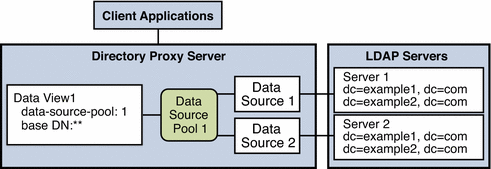
Because the base DN of the data view is the rootDSE, the data view encompasses the base DN of all possible requests. All requests are forwarded to the data source pool, irrespective of the target DN or whether the data source contains an entry for the request.
If Directory Proxy Server receives a request with a target DN that does not exist in the data source, the request is forwarded to the data source pool. The data source that responds to the request returns an error.
For information about how to configure the data view in Figure 22–3, see Data Views That Route All Requests, Irrespective of the Target DN of the Request in Sun Java System Directory Server Enterprise Edition 6.0 Administration Guide.
Data Views to Route Requests When a List of Subtrees Are Stored on Multiple, Data-Equivalent Data Sources
This section describes data views that route requests targeted at a list of subtrees to a set of data-equivalent data sources.
The example in this section has multiple data sources that each contain the same set of subtrees. The data sources are data-equivalent and pooled into one data source pool for load balancing. A data view is configured for each subtree to expose that subtree to client requests. Figure 22–3 shows the example deployment.
Figure 22–4 Example Deployment That Routes Requests When a List of Subtrees Is Stored on Multiple, Data-Equivalent Data Sources

A request is exposed to a data view only if the target DN is subordinate to the base DN of the data view. When a request is exposed to a data view, the request is forwarded to the data source pool specified by the data view.
If the target DN of a request is not subordinate to the base DN of any data view, Directory Proxy Server returns an error.
In Figure 22–4, requests that target dc=example1,dc=com or dc=example2,dc=com are forwarded to the data source pool. Directory Proxy Server returns an error for requests that target neither dc=example1,dc=com nor dc=example2,dc=com.
For information about how to configure the data views in this section, see Data Views That Route Requests When a List of Subtrees Is Stored on Multiple, Data-Equivalent Data Sources in Sun Java System Directory Server Enterprise Edition 6.0 Administration Guide.
Data Views to Provide a Single Point of Access When Different Subtrees Are Stored on Different Data Sources
This section describes how Directory Proxy Server provides a single point of access to different subtrees of data on multiple data sources. The example in this section contains a data view is for each subtree, to expose that subtree to client requests. A data source pool is configured for each set of data-equivalent data sources. Figure 22–5 shows the example deployment.
Figure 22–5 Example Deployment That Provides a Single Point of Access When Different Subtrees Are Stored on Different Data Sources
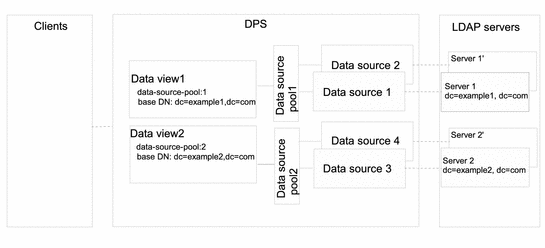
The Directory Proxy Server exposes a request to a data view if the DN targeted by the request is subordinate to the base DN of the data view. When a request is exposed to a data view, the request is forwarded to the data source pool specified by the data view.
If a request has a target DN that is not subordinate to the base DN of a data view, Directory Proxy Server returns an error.
In Figure 22–5, client requests that target dc=example1,dc=com are forwarded to the data source pool 1 and are treated by data source 1 or data source 1'. Client requests that target dc=example2,dc=com are forwarded to the data source pool 2 and are treated by data source 2 or data source 2'. The Directory Proxy Server returns an error for client requests that target neither dc=example1,dc=com nor dc=example2,dc=com.
For information about how to configure a data view to provide a single point of access to different subtrees stored in multiple data sources, see Data Views That Provide a Single Point of Access When Different Subtrees Are Stored on Different Data Sources in Sun Java System Directory Server Enterprise Edition 6.0 Administration Guide.
Data Views to Route Requests When Different Parts of a Subtree Are Stored in Different Data Sources
This section describes how Directory Proxy Server provides a single point of access to different parts of a subtree stored in multiple data sources. To route requests for different parts of a subtree, Directory Proxy Server uses a distribution algorithm. In the example in this section, Directory Proxy Server uses the numeric distribution algorithm. For more information about distribution algorithms, see Distributing Entries In a Subtree to Different Data Views.
The example in this section contains two data views with the same base DN. A numeric distribution algorithm is used to separate entries into different data views. A data source pool is configured for each set of data-equivalent data sources. Figure 22–6 shows the example deployment.
Figure 22–6 Example Deployment That Routes Requests When Different Parts of a Subtree Are Stored in Different Data Sources
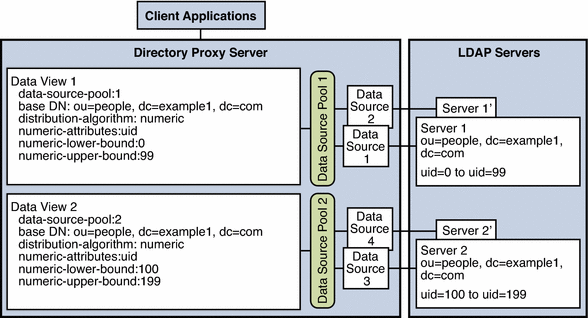
Directory Proxy Server exposes a request to the data view which satisfies the following conditions:
-
The DN targeted by the request is subordinate to the base DN of the data view
-
The parameters of the requests match the pattern specified by the distribution algorithm in the data view
When a request is exposed to a data view, the request is forwarded to the data source pool specified by the data view.
If a request that does not match the conditions of any data view, Directory Proxy Server returns an error.
For information about how to configure a data view to provide a single point of access to different parts of subtree on multiple data sources, see Data Views That Provide a Single Point of Access When Different Parts of a Subtree Are Stored in Different Data Sources in Sun Java System Directory Server Enterprise Edition 6.0 Administration Guide.
Data Views to Route Requests When Superior and Subordinate Subtrees Are Stored in Different Data Sources
This section describes how Directory Proxy Server provides a single point of access when a superior branch of a subtree is stored in a different data source to a subordinate branch.
By default, Directory Proxy Server automatically sets the excluded-subtrees property and the alternate-search-base-dn property. However, the automatic management of the excluded-subtrees property and the alternate-search-base-dn property can be disabled. For information about how to manually configure the excluded-subtrees property and the alternate-search-base-dn property, see To Manually Configure the excluded-subtrees and alternate-search-base-dn Properties in Sun Java System Directory Server Enterprise Edition 6.0 Administration Guide.
The example in Figure 22–7 contains three data views. The base DN of dataview–1 is superior to the base DNs of dataview-2 and dataview-3.
The excluded-subtrees property on dataview-1 excludes dataview-2 and dataview-3 from dataview-1. The alternate-search-base-dn properties on dataview-2 and dataview-3 include dataview-2 and dataview-3 in search operations targeted at dataview-1. Figure 22–7 shows the example deployment.
Figure 22–7 Example Deployment to Route Requests When Superior and Subordinate Subtrees Are Stored in Different Data Sources
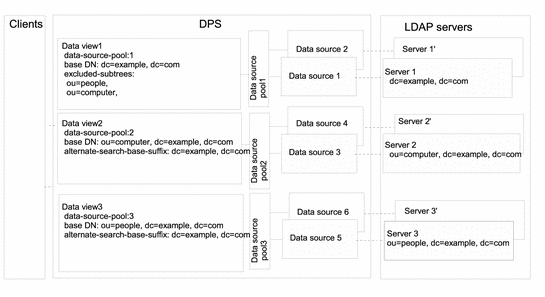
Directory Proxy Server exposes a request to the data view which satisfies the following conditions:
-
The DN targeted by the request is subordinate to the base DN of the data view
-
The DN targeted by the request is not excluded from the data view by the excluded-subtrees parameter
When a request is exposed to a data view, the request is forwarded to the data source pool specified by the data view.
If a request does not match the conditions of any data view, the request cannot be exposed to a data view and Directory Proxy Server returns an error.
In Figure 22–7, client requests that target dc=example1,dc=com but do not target ou=computer, dc=example, dc=com or ou=people, dc=example, dc=com are forwarded to the data source pool 1. Such requests are treated by data source 1 or data source 1'. Client requests that target ou=computer, dc=example, dc=com or ou=people, dc=example, dc=com are forwarded to data source pool 2 and data source 3, respectively. Directory Proxy Server returns an error for client requests that do not target dc=example,dc=com.
All three data views are candidates for search operations that are targeted at dc=example,dc=com.
For information about how to configure a data view to provide a single point of access to different parts of subtree in multiple data sources, see Data Views That Provide a Single Point of Access When Superior and Subordinate Subtrees Are Stored in Different Data Sources in Sun Java System Directory Server Enterprise Edition 6.0 Administration Guide.
Data Views With Hierarchy and a Distribution Algorithm
Different data views can be used in the same topology to expose or hide parts of a subtree. Figure 22–8 shows are an example with data views that combine the hierarchy shown in Figure 22–7 with the distribution algorithms shown in Figure 22–6.
The example in Figure 22–8 contains four data views. The base DN of data view 1 is superior to the base DNs of the other data views. Data view 3 and data view 4 have the same base DN, but a numeric distribution algorithm separates entries into the different data views. Figure 22–8 shows the example deployment.
Figure 22–8 Data View With Hierarchy and a Distribution Algorithm
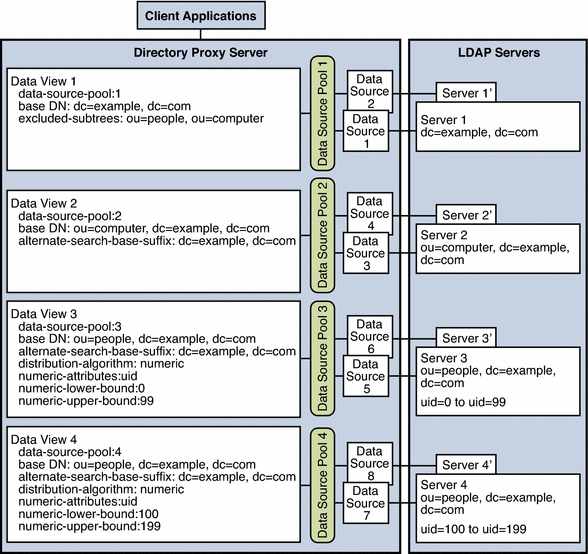
The excluded-subtrees property on dataview-1 excludes the other data views from dataview-1. The alternate-search-base-dn property on dataview-2, dataview-3, and dataview-4 includes these data views in search operations targeted at dataview-1.
Directory Proxy Server exposes a request to the data view which satisfies the following conditions:
-
The DN targeted by the request is subordinate to the base DN of the data view
-
The DN targeted by the request is not excluded from the data view by the excluded-subtrees parameter
-
The parameters of the requests match the pattern specified by the distribution algorithm
When a request is exposed to a data view, the request is forwarded to the data source pool specified by the data view.
If a request does not match the conditions of any data view, Directory Proxy Server returns an error.
For information about how to configure a complex data view, see Data Views With Hierarchy and a Distribution Algorithm in Sun Java System Directory Server Enterprise Edition 6.0 Administration Guide.
- © 2010, Oracle Corporation and/or its affiliates
